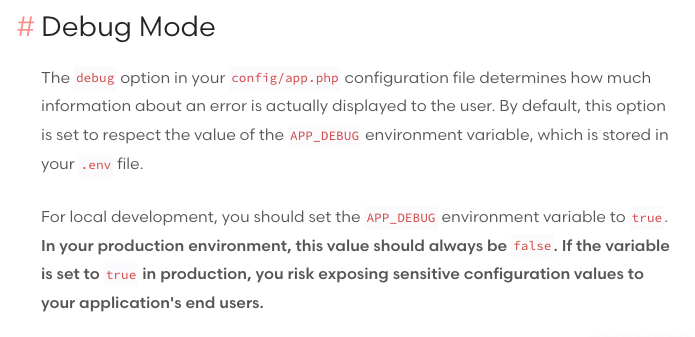Laravel's debugging mode is quite rich. Laravel's official website has a reminder that you can set APP_DEBUG to true for local development, but in the production environment, this value must always be False. 
Although you can use php artisan down The way to enter the maintenance mode, plus the secret can be accessed.
artisan down --secret=NWQwODZhNTM0ODY5Zjc1MDdkMWI4NzIy
Then use the URL to open and add the set secret
https://yourserver.example/NWQwODZhNTM0ODY5Zjc1MDdkMWI4NzIy
But if you are developing something, you need an external network environment, such as a BOT webhook, How to tell it🥺, at least you must be able to lock an external network IP.
My current approach is to adjust config/app.php, so that I can decide whether to start the DEBUG mode through the external network.
/*
|--------------------------------------------------------------------------
| Application Debug Mode
|--------------------------------------------------------------------------
|
| When your application is in debug mode, detailed error messages with
| stack traces will be shown on every error that occurs within your
| application. If disabled, a simple generic error page is shown.
|
*/
//'debug' => (bool) env('APP_DEBUG', false),
'debug' => env('APP_DEBUG', ($_SERVER[env("PROXY_REAL_IP","REMOTE_ADDR")]??"null") == env('APP_CAN_DEBUG','') ? true : false),
In the above setting, we can change the APP_DEBUG of .env to APP_CAN_DEBUG=my external network IP.
If necessary, add PROXY_REAL_IP to define the real IP that the host or container can obtain.
In this way, as long as you need to make relevant settings in .env, you can enter Debug mode with peace of mind.
When not in use, adjust APP_CAN_DEBUG in .env to false to lock it.
#APP_CAN_DEBUG=false
PROXY_REAL_IP=HTTP_X_REAL_IP
APP_CAN_DEBUG=111.248.117.140
PROXY_REAL_IP is used to set the real IP of the Proxy in the header, which can be set according to your own environment.
Like HTTP_X_FORWARDED_FOR or HTTP_X_REAL_IP etc.
We can write a simple Route and use phpinfo to check our external network IP and the header name of $_SERVER to confirm whether there is any setting error.
Route::get('/myphpinfo', function(){
phpinfo();
});



No Comment
Post your comment